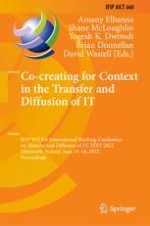2022 | Buch
Co-creating for Context in the Transfer and Diffusion of IT
IFIP WG 8.6 International Working Conference on Transfer and Diffusion of IT, TDIT 2022, Maynooth, Ireland, June 15–16, 2022, Proceedings
herausgegeben von: Amany Elbanna, Shane McLoughlin, Yogesh K. Dwivedi, Brian Donnellan, David Wastell
Verlag: Springer International Publishing
Buchreihe : IFIP Advances in Information and Communication Technology
